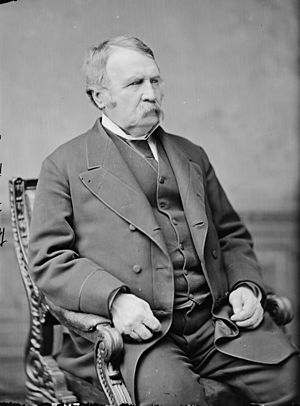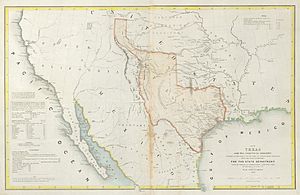William H. Emory facts for kids
Quick facts for kids
William Hemsley Emory
|
|
|---|---|
 |
|
| Born | September 7, 1811 Queen Anne's County, Maryland |
| Died | December 1, 1887 (aged 76) Washington, D.C. |
| Place of burial |
Congressional Cemetery
|
| Allegiance | United States Union |
| Service/ |
United States Army Union Army |
| Years of service | 1831–1836, 1838–1876 |
| Rank | |
| Commands held | XIX Corps |
| Battles/wars | Mexican–American War American Civil War |
William Hemsley Emory (September 7, 1811 – December 1, 1887) was a prominent American surveyor and civil engineer in the 19th century. As an officer in the U.S. Army Corps of Topographical Engineers he specialized in mapping the United States border, including the Texas–Mexico border, and the Gadsden Purchase border, 1844–1855, and published lasting scientific reports on the border region.
Contents
Early life and early career
Emory was born in Queen Anne's County, Maryland, on his family's "Poplar Grove" estate. He attended the United States Military Academy at West Point, New York, and graduated in 1831. Assigned as a second lieutenant, he served in the Fourth Artillery until he resigned from the service in 1836 to pursue civil engineering, but he returned to the service in 1838 as lieutenant in the newly formed Corps of Topographical Engineers.
William H. Emory was most importantly a topographical engineer and explorer. From 1839 to 1842, he surveyed harbors and the Delaware River. In 1844, Emory served in an expedition that produced a new map of Texan claims westward to the Rio Grande, which brought him national attention as the war with Mexico seemed imminent. He next conducted a boundary survey of the Canada–United States border (1844–1846). His mapmaking skills were so superb and detailed with such great accuracy that he often made other maps obsolete, thus making him the authority of the trans-Mississippi west.
Mexican–American War and Gadsden Purchase
At the start of the Mexican–American War, Emory was selected to join General Stephen Watts Kearny and the Army of the West to take New Mexico and California. Along the way he kept a detailed journal of the march down the Rio Grande and across to the Gila River, and down it to its mouth on the Colorado River, then to the Pacific coast. Published by the Thirtieth United States Congress in 1848 as Notes of a Military Reconnaissance from Fort Leavenworth to San Diego, it became an important guide book for the road to Southern California. This report described terrain and rivers, cities and forts and made observations about Native Americans and Mexicans, primarily in the future New Mexico Territory, Arizona Territory and Southern California. It was and is considered one of the important chronicles and descriptions of the historic Southwest, particularly noted for its maps. Emory was a reliable and conscientious cartographer.
After the War, Emory was sent with a crew to survey the new United States-Mexico boundary, first from the mouth of the Gila across California to the coast and then second, with the Bartlett survey from El Paso west, 1849–1853. A dispute arose among the Mexicans and Americans over the location of the starting line near El Paso caused by an error in the original map referred to in the Treaty of Guadalupe Hidalgo (1848). A compromise by John Bartlett brought an international incident when neither side agreed to the boundary and threatened renewed hostilities in the Mesilla Valley above El Paso. A compromise was reached with the Gadsden Purchase of 1854, and Emory was selected to lead the American boundary commission to survey, 1855–1856, the new boundary line (earlier he had influenced the debate over approving the treaty by advising Senator Thomas Jefferson Rusk of Texas on the best route for a southern transcontinental railroad, one of the key points of the Gadsden Treaty).
There is a story of testament as to Emory's dedication to accuracy that says John Bartlett, his supervisor in the boundary survey, made him sign off on a misplaced boundary marker, creating a sweet revenge for Emory who replaced him as Head of the International Boundary Commission in 1855. But William H. Emory did more than just map the terrain; he also made notes about the plant life as well as the people who inhabited the sparsely populated Southwest. Notating the social relations of some of the Native American people, he wrote: "Women, when captured, are taken as wives by those who capture them, but they are treated by the Indian wives of the capturers as slaves, and made to carry wood and water; if they chance to be pretty, or receive too much attention from their lords and masters, they are, in the absence of the latter, unmercifully beaten and otherwise maltreated. The most unfortunate thing which can befall a captive woman is to be claimed by two persons. In this case, she is either shot or delivered up for indiscriminate violence."[2] His multi-volume boundary survey published as the Report of the United States and Mexican Boundary Commission, Made Under the Direction of the Secretary of the Interior, 2 vols (Washington, GPO, 1857–1859, reprint Austin:Texas Historical Association, 1987) was not only a contribution to understanding the geography of the region but was a long-standing scientific contribution to the natural history of the region.
American Civil War
In 1861, when the American Civil War broke out, Emory was stationed in the Indian Territory. Anticipating the possible capture of his troops by Confederates, he secured the services of Black Beaver, a famous Lenape warrior, to guide Emory's troops to safety. He promised that the government would compensate Black Beaver for the loss of his ranch. Emory withdrew Union troops from Fort Washita to Fort Leavenworth. During the withdrawal, Black Beaver scouted pursuing enemy troops, and Emory attacked and captured lead elements of his pursuers, the first prisoners captured during the Civil War.
At the onset of the Civil War, Emory was concerned for his family and wrote a letter of resignation on May 9, 1861. He immediately regretted his decision and tried to prevent the delivery of the letter but was unable to do so. In spite of his resignation letter, he was informally commissioned as major general of the 3rd, later 6th, Cavalry. However, an official review was required that included testimony on his behalf from General Winfield Scott and Lieutenant A. V. Colburn, as well as Emory's own testimony to Secretary of War and the Senate before his resignation was formally rescinded and his rank was officially confirmed.
Emory served as a brigade commander in the Army of the Potomac in 1862, and was transferred to the Western Theater. He was promoted to brigadier general of volunteers on March 17, 1862. He later commanded a division in the Port Hudson campaign. He subsequently returned to the East as the commander of the Nineteenth Corps, serving in all the major battles in the Shenandoah Valley Campaign of 1864, especially at the Battle of Cedar Creek, where Emory's actions helped save the Union army from a devastating defeat until Maj. Gen. Philip Sheridan's arrival.
At the end of the war, Emory held the rank of colonel in the regular army and a brevet (honorary promotion) as major general. He was promoted to major general in the volunteers on September 25, 1865 and was mustered out of the volunteers on January 15, 1866.
Postbellum
After the war, Emory held a number of posts, most importantly commander of the Department of the Gulf (which included the Federal troops in Louisiana, Arkansas, and Mississippi)–a demanding and dangerous Reconstruction assignment. In September 1874, President Ulysses S. Grant ordered Emory to New Orleans, where he successfully negotiated a peace with the conservative White League who had taken over the city by military force. As a result, Republican Governor Kellogg was restored to power and the White League disbanded. For political reasons, General Sheridan removed Emory from command and saw to it that he was retired in 1876. The Department of the Gulf was soon shifted to Sheridan's large Division of the Missouri, which included Texas.
He was a companion of the Military Order of the Loyal Legion of the United States. In 1879 he became a Veteran Member of the Aztec Club of 1847.
Marriage and family
Emory married Matilda Wilkins Bache on May 29, 1838, in Philadelphia, Pennsylvania. Bache was the daughter of Richard Bache Jr. and Sophia Burrell Dallas. She was a granddaughter of Sarah Franklin Bache and Richard Bache, and a great-granddaughter of Benjamin Franklin, as well as a niece of George Mifflin Dallas, the 11th Vice President of the United States, serving under James K. Polk.
Emory and his wife had a total of 10 children. His eldest son, Brevet Lieut. Colonel Campbell Dallas Emory, 9th United States Infantry, was Aide de Camp to Major General George G. Meade during the Civil War, and a younger son, William H. Emory Jr., was a rear admiral in the United States Navy.
Death
Emory died December 1, 1887, in Washington, D.C. He is buried in the Congressional Cemetery there.
Legacy
While attending the United States Military Academy at West Point, he earned the nickname "Bold Emory".
Emory Pass, 8,228 feet, in the Black Range of southwest New Mexico was named for him.
Emory Peak (7,825 ft) in Big Bend National Park is named for him.
Fort Emory was named for him in 1942. It is now used as a training area for Special Forces.
In 1853, Baird and Girard named the Great Plains rat snake, Pantherophis emoryi, for Emory. The first specimens of this snake species were collected by John H. Clark and Arthur Schott at Howard Springs, Texas, under Emory's leadership during the United States and Mexican Boundary Survey. Emory is also commemorated in the scientific name of the Texas spiny softshell turtle, Apalone spinifera emoryi, Emory's crucifixation thorn (Castela emoryi) of the Simaroubaceae family, the cacti Grusonia emoryi and Bergerocactus emoryi, as well as the genus Emorya in the Buddleja tribe of the plant family Scrophulariaceae.
Emory Elementary School in San Diego bears his namesake, and is located 2.5 miles (4.0 km) north of the border which he determined between the United States and Mexico from the Colorado River to San Diego/Tijuana, near the border's western end.
The astronauts of Apollo 17 named a small crater after him.
See also
 In Spanish: William Hemsley Emory para niños
In Spanish: William Hemsley Emory para niños


